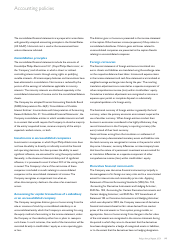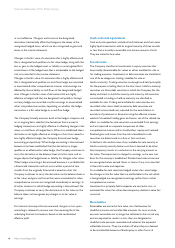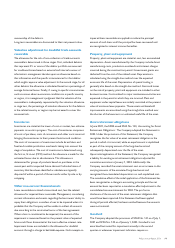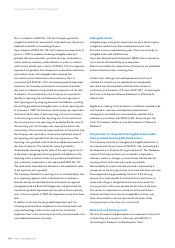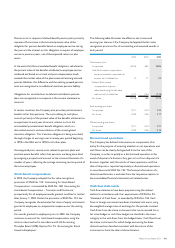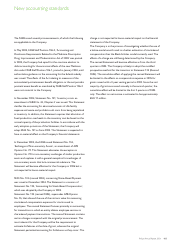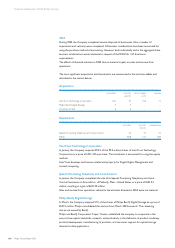Philips 2004 Annual Report Download - page 99
Download and view the complete annual report
Please find page 99 of the 2004 Philips annual report below. You can navigate through the pages in the report by either clicking on the pages listed below, or by using the keyword search tool below to find specific information within the annual report.or are ineffective. The gains and losses on the designated
derivatives substantially offset the changes in the values of the
recognized hedged items, which are also recognized as gains and
losses in the income statement.
Changes in the fair value of a derivative that is highly effective and
that is designated and qualifies as a fair value hedge, along with the
loss or gain on the hedged asset, or liability or unrecognized firm
commitment of the hedged item that is attributable to the hedged
risk, are recorded in the income statement.
Changes in the fair value of a derivative that is highly effective and
that is designated and qualifies as a cash flow hedge, are recorded
in accumulated other comprehensive income, until earnings are
affected by the variability in cash flows of the designated hedged
item. Changes in the fair value of derivatives that are highly
effective as hedges and that are designated and qualify as foreign
currency hedges are recorded in either earnings or accumulated
other comprehensive income, depending on whether the hedge
transaction is a fair value hedge or a cash flow hedge.
The Company formally assesses, both at the hedge’s inception and
on an ongoing basis, whether the derivatives that are used in
hedging transactions are highly effective in offsetting changes in fair
values or cash flows of hedged items. When it is established that a
derivative is not highly effective as a hedge or that it has ceased to
be a highly effective hedge, the Company discontinues hedge
accounting prospectively. When hedge accounting is discontinued
because it has been established that the derivative no longer
qualifies as an effective fair value hedge, the Company continues to
carry the derivative on the balance sheet at its fair value, and no
longer adjusts the hedged asset or liability for changes in fair value.
When hedge accounting is discontinued because it is probable that
a forecasted transaction will not occur within a period of two
months from the originally forecasted transaction date, the
Company continues to carry the derivative on the balance sheet at
its fair value, and gains and losses that were accumulated in other
comprehensive income are recognized immediately in earnings. In
all other situations in which hedge accounting is discontinued, the
Company continues to carry the derivative at its fair value on the
balance sheet, and recognizes any changes in its fair value in
earnings.
For interest rate swaps that are unwound, the gain or loss upon
unwinding is released to income over the remaining life of the
underlying financial instruments, based on the recalculated
effective yield.
Cash and cash equivalents
Cash and cash equivalents include all cash balances and short-term
highly liquid investments with an original maturity of three months
or less that are readily convertible into known amounts of cash.
They are stated at face value.
Investments
The Company classifies its investments in equity securities that
have readily determinable fair values as either available-for-sale or
for trading purposes. Investments in debt securities are classified in
one of three categories: trading, available-for-sale or
held-to-maturity. Trading securities are bought and held principally
for the purpose of selling them in the short term. Held-to-maturity
securities are those debt securities in which the Company has the
ability and intent to hold the security until maturity. All securities
not included in trading or held-to-maturity are classified as
available-for-sale. Trading and available-for-sale securities are
recorded at fair value. Held-to-maturity debt securities are
recorded at amortized cost, adjusted for the amortization or
accretion of premiums or discounts using the effective interest
method. Unrealized holding gains and losses, net of the related tax
effect, on available-for-sale securities are excluded from earnings
and are reported as a separate component of other
comprehensive income within stockholders’ equity until realized.
Realized gains and losses from the sale of available-for-sale
securities are determined on a first-in, first-out basis.
A decline in the market value of any available-for-sale security or
held-to-maturity security below cost that is deemed to be other
than temporary results in a reduction in the carrying amount to
fair value. The impairment is charged to earnings, and a new cost
basis for the security is established. Dividend and interest income
are recognized when earned. Gains or losses, if any, are recorded
in financial income and expenses.
For available-for-sale securities hedged under a fair value hedge,
the changes in the fair value that are attributable to the risk which
is being hedged are recognized in earnings rather than in other
comprehensive income.
Investments in privately-held companies are carried at cost, or
estimated fair value if an other-than-temporary decline in value has
occurred.
Receivables
Receivables are carried at face value, net of allowances for
doubtful accounts and uncollectible amounts. As soon as trade
accounts receivable can no longer be collected in the normal way
and are expected to result in a loss, they are designated as
doubtful trade accounts receivable and valued at the expected
collectible amounts. They are written off when they are deemed
to be uncollectible because of bankruptcy or other forms of
98 Philips Annual Report 2004
Financial statements of the Philips Group











